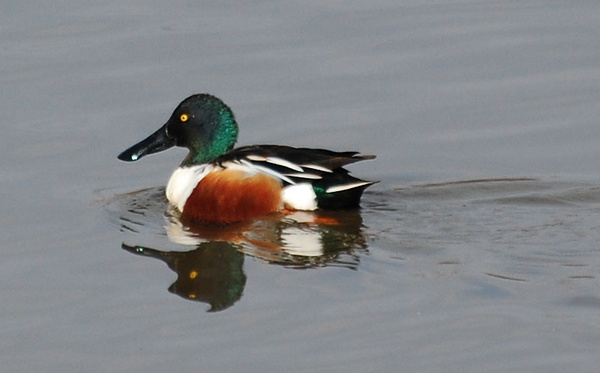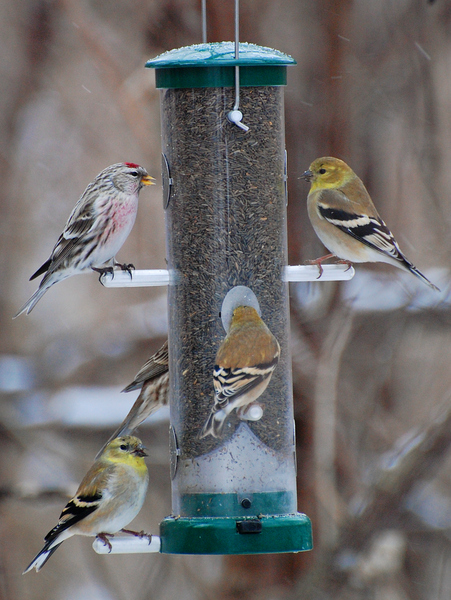
Surprise appearance at Dutch Gap
January 19th, 2011
I always make a trip to Dutch Gap when I visit Richmond. It's a conservation area on the James River. In winter, the hotspot is the marshes, where wintering waterfowl congregate, and Bald Eagles often perch in the branches above. There's no boardwalk (used to be, but they closed it down), but there are several points where you can stop your car and look out over the marsh from elevated platforms.
At the first lookout point, I saw some mystery ducks in the distance, swimming in and out of the vegetation. They had all-green heads like mallards, but their deep chestnut-colored flanks gave them away as something more exotic. I had no field guide on hand, but when I studied the pictures I took on my camera LCD and saw how long their bills were, I knew they could only be one thing: Northern Shovelers! A species I'd only ever seen at a huge distance away, in eclipse (drab brown) plumage, once. It's a rare species in Ottawa, at least at the places I frequent.
They were too far away for good photos. But we drove on to the next lookout point and struck gold: there was one swimming right out in the open!

These ducks forage with their long, spoon-shaped bills lowered in the water. Comblike projections (lamellae) around the edges of the bill strain out small crustaceans, aquatic insects and other food. Unlike some dabbling ducks, they don't tip up.
It takes a profile shot to show just how long the bill is:

Escaping Ottawa Winter
January 12th, 2011
I know I'm not in Canada anymore when I get 30 species in one day in January!
I'm on vacation in Virginia this week, visiting my folks and birding away. The theme of the trip is shaping up to be "Red-Shouldered Hawks." I didn't realize what common winter residents they are here, or that many of the buteos I've previously dismissed as Red-Tailed Hawks were probably this species. I've seen three of them today, and photographed one. The lighting was not my friend--I would have had to go into someone's yard to get the sun in the right place for him, and I don't do that unless invited. But I did get a nice flight photo, even though it's mostly in silhouette. Hermit Thrush, Bluebird, Turkey Vulture, Mockingbird and others also presented for the camera.
With the storm past, we're having beautiful sunny weather here, and while my parents complain about the cold, I'm practically basking in what is to me autumn-like weather (5C, crisp and dry.) I expect to be outdoors a lot!
Odd Man Out
January 6th, 2011
Common Redpolls, those winteriest of winter birds, with their little crimson caps and delicate trills, have finally arrived at my local feeders! A small number of them have joined the goldfinches at the nyjer. They've been at Shirley's Bay for awhile, of course. But it's certainly nicer to be able to see them five minutes walk from my home.

Close-up:

They're finally here!
December 26th, 2010
Today at the Shirley's Bay feeders, a sight I've eagerly awaited: a flock of redpolls!. It's a sight I hadn't enjoyed since February of 2009, since they didn't come south last winter. With them, some American Tree Sparrows, some goldfinches, other common birds, a female Pileated Woodpecker, and a great teeming gaggle of nature photographers. Passing overhead, large flocks of Bohemian Waxwings--wish fulfillment number two.
Sometime in the next few days I'm going back there with the camera and join the gaggle. Of course, with any luck, the redpolls will soon find their way to my own little nyjer feeder at Hurdman so I don't have to go across town to photograph them.
Chickadee
December 15th, 2010

A cloudy day at the Hurdman feeders
December 14th, 2010
Yesterday at the Hurdman feeders was the most frenetic I've seen...there or anywhere. Teeming masses of goldfinches, house finches and chickadees, whizzing back and forth, fighting over perches. Every perch on the nyjer feeder occupied. Woodpeckers and nuthatches stuffing themselves on suet. I filled the platform feeder almost to the brim in the morning; by afternoon, they'd emptied it. I guess they knew the weather was only going to get worse.

House Finch

American Goldfinch

Downy Woodpecker

White-Breasted Nuthatch

Black-Capped Chickadee and a very tenacious squirrel :-)
Ring-Billed Gull
November 30th, 2010

Another surprisingly handsome common bird. I like the bright red rings around their eyes.
Common Grackle
November 28th, 2010
Taken on the shore of Mud Lake in late April. A lot of people don't realize how gorgeous grackles are close up and in good light!

1680x1050 wallpaper
King Of Corvids
November 26th, 2010
This raven came along while I was watching diving ducks on Wednesday. He was heralded in the usual way: by the sound of angry crows!

I bet you look at that picture and imagine him making a loud "grawk!", right? Nope. The sound he actually made (repeatedly) was a delicate, hollow little *pop*--like the sound of water droplets. Each time opening his beak wide and fluffing out his throat feathers dramatically, all to deliver this tiny sound effect. Gotta love ravens.

Maybe *pop* was code for, "anybody want to share this?"
A morning on the Rideau (part 2)
November 25th, 2010
The Hooded Merganser is an odd-looking duck at the best of times. So when a wind ruffled this guy's crest feathers, he looked beyond odd--like something had come and taken a bite out of him!

Here he is looking a little more dignified:

"Hoodies" are common spring and fall migrants in Ottawa. They don't usually winter here. Right now you can find them just south of Riverain Park, often swimming right along shore (but you have to peek through the reeds to see them.) Oddly, Hooded Mergansers are known to hybridize, in the wild, with both species of goldeneye. That's not merely a cross-species hybrid, but cross-genus!
A Common Merganser trio:

And one rather disheveled looking Scaup--probably a molting juvenile. This is another late migrant.

|
